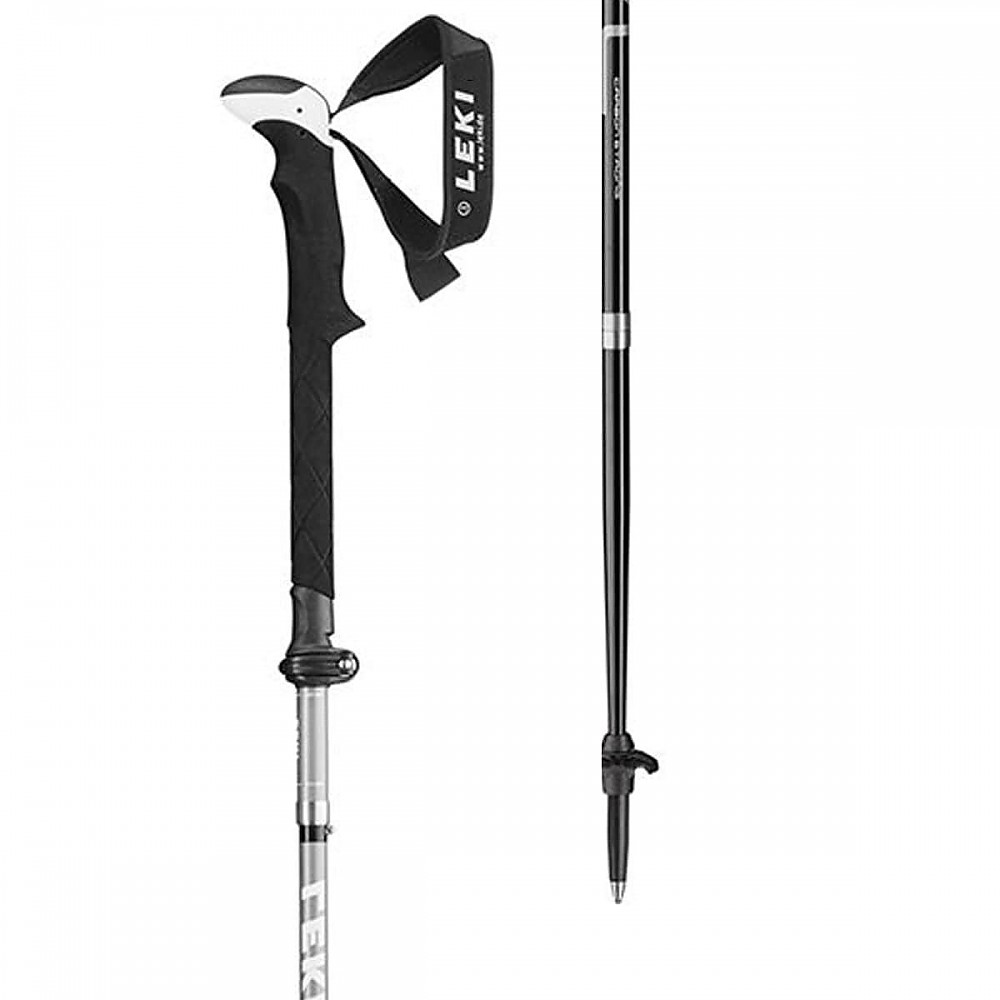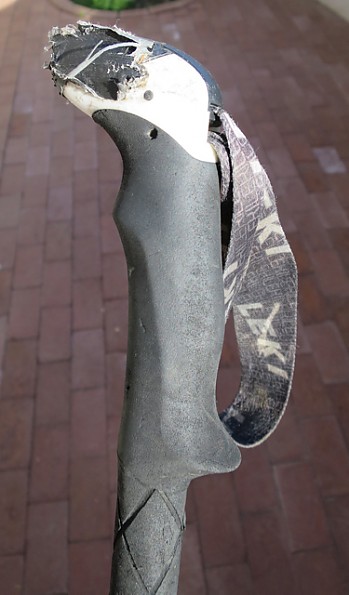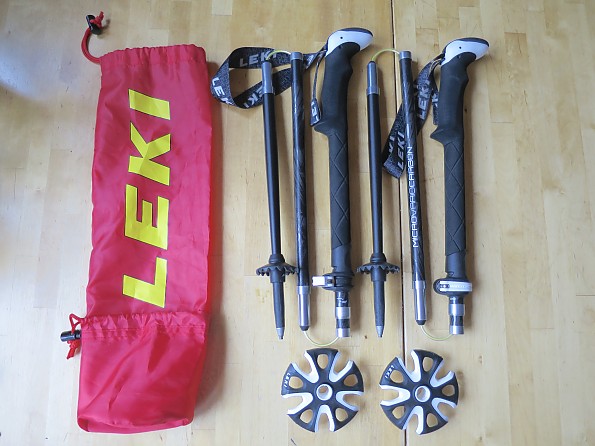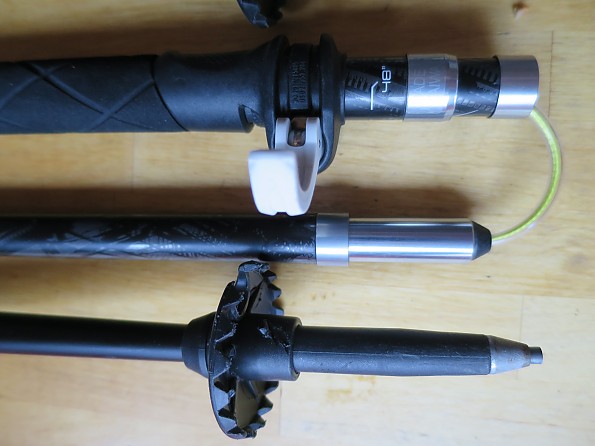Leki Micro Vario Carbon Max

The Micro Vario Carbon Max is a trekking and backcountry ski pole made for vertically advantaged (over 6' or 180 cm) people. Light (but not ultralight), stiff, and strong. Great for hiking and backpacking and a good choice for ski mountaineering, with a good length range and versatile grip options for movement on easy ground and up, down, and across steeper and rougher slopes.
Pros
- Light, stiff, and strong
- Collapse/fold to 39 cm (15.4 in)
- Very well made
- Adjustable length 120-140 cm (47-55 inches), suitable for folks over 180 cm (about 6 feet)
- Versatile grips
Cons
- Not ultralight (570 g/pair)
- Bulky when folded, especially with snow baskets
- Price ($200)
- Not quite long enough for mixed terrain skiing (at my height anyway)
- Incompatible with pole holsters on some packs
Trailspace sent these poles to me because they are specifically made for vertically advantaged (tall) people; at over 190 cm (6'3"), I’m TS’s man for the job. ”Max” refers to extra length – the standard length version of these poles tops out at 130 cm (51 inches), but these extend to 140 cm (55 in).
The prospectus also mentions that they are suitable for backcountry/AT skiing, an activity that looms large on my resume. While 140 cm is actually 5 cm more than I need for hiking on trails, I have BC ski poles that extend to 145 cm and occasionally use them at that length for double poling on flat runouts. A full length classic Nordic pole for me is 155 cm.
Test Conditions
I have been using the Micro Vario Carbon Max poles for about three months, for trail running in icy or snowy conditions, day and overnight hikes, and backcountry ski tours on packed trails and in powder snow.
The poles come in a spiffy red stuff sack and include both standard trekking baskets and snow baskets. They are a hybrid between a lightweight section pole and a telescoping pole. They telescope fold into three sections. The tradeoff of the folding poles is volume — with trekking baskets the bundle is only about 39 cm (15.4 in) long, but has an effective diameter approaching 10 cm (4 in).
These poles are not ultralight. I weighed them at 570 grams for the pair, nearly 200 g heavier than some fixed length folding poles, more than 150 g heavier than the standard length Micro Varios (414 g according the the website), and in the same weight range as the metal/carbon fiber hybrid 3-section trekking poles and the 145 cm max length 2-section hybrid BC ski poles that I have in my quiver.
This is probably due not only to the extra 10 cm of length, but also the substitution of aluminum in the lower shaft. When running on the flats while just holding the poles out behind me, I found that my hands tired quickly from the downward leverage of the pole shaft; a full-on trail running pole should probably have a lighter lower shaft more like a Nordic ski pole.
The pole shafts are beautifully engineered. The sections are joined by precisely machined aluminum fittings. The upper section has both a sliding section that takes up the slack in the plastic-coated Kevlar cables that keep the parts together, and a telescoping section with a cam lock with a 20 cm (8 in) range, so that there are actually five shaft pieces overall.
According to the manufacturer, the lower piece is aluminum, while the rest of the parts are carbon fiber. The overall length range of the poles is 120 to 140 cm.
Unfolding and locking the poles is smooth and easy: you hold the pole vertically with the lower sections dangling and slide out the locking shaft until a locking button snaps into place. The conical heads of the male fitting find their way easily into the female side. There is a spring or elastomer tensioner hidden in the upper part that comes into play in the last few cm before the shaft locks into place. The tension holds the sections solidly in place with no movement during use (if you tug real hard you can open up a 1 cm gap, but that's not enough to get them to come apart).
Telescoping the upper section to different lengths is also smooth but slightly stiff; loosening the cam locks doesn’t make much difference. The levers are made of a tough, stiff plastic and are compact. Locking is very reliable — I have had zero problems with slippage.
One of the best features of these poles is that they are very stiff, which is good not only for energy transfer but makes them less likely to bow and break when catching a fall. The only way to really know how strong they are is to bend them to the breaking point, but based on their stiffness I feel like I can trust them to catch me on a backward slip even with a loaded pack.
These poles do not work well with the pole holsters found on some packs, a setup that allows you to park your poles along the side of your pack without taking it off, to free up your hands for scrambling or whatever. That system relies on collapsing a three-section telescoping pole to minimum length, but with these folding is the only option to get them under 120 cm. I have a pack with a pole holster, but so far haven’t used it all that much, so I don’t think I myself would miss having that option.
The grips are made of molded plastic covered by a tough, high density foam that provides good friction even when wet. As with most types of trekking and BC ski poles, they are molded to fit in the hand with a ridge to support the index finger.
A recent review of the cork version of these grips mentioned that they were a little too small in diameter. I have big hands (wear extra large gloves), but I didn’t particularly notice this, maybe because I am used to the even narrower grips on Nordic ski poles.
It took me a while to make friends with the bulbous pommels (for want of better words) at the top of the grips. At first they seemed to get in the way of Nordic-style arm extension, where you release the pole as you push off. But these poles aren’t really made for cross-country skiing. And then I figured out what they are really for. The black top cap is rubberized to prevent slippage and the pommels fit nicely in the palm of the hand, so with fingers wrapped under the overhang you get a comfortable top grip that you can slide into easily for a little extra reach now and then. While you can do this move with other trekking poles, these give a much more comfortable grip.
The non-slip foam also extends another 20 cm down onto the shaft of the pole, so that you can shift to a lower “choke” grip to keep the uphill hand low. On steeper slopes in powder snow, where I have to lift my hands a little higher to get the pole up out of the snow, I have used the uphill pole set at 120 cm and the lower at 140 cm, and sometimes used the choke and pommel grips, respectively, to keep my arms comfortably between shoulder and waist height.

Using different length poles on a traverse with the choke grip (left) and pommel grip (right)
On my second trail run using the poles, I noticed a rattling noise coming from one of the grips from something loose inside. When I got home I pried the top of the grip open and shook the loose piece out, but it fell on the floor and I was unable to find it, so I don’t know what it was. The top of the grip did not snap back into place as I expected and so it is now slightly cracked open as a result, but I have not had any other problems with that pole grip.
Straps
The straps are made of a thin, flat, smooth, ribbon-like material, described as “air-textured” in the product specs. The strap is lightweight and comfortable on bare hands. My main concern would be how well it will hold up in the long run, but I suppose if it is easily replaced and if it holds up for at least a few full seasons that shouldn’t be too much of a problem.
The strap length adjusts easily and quickly using a locking lever on the top of the grip, one of the better strap adjustment mechanisms I have seen. However, the lever is opened by pulling upward on the strap, and this can happen accidentally when using the poles Nordic style with full backward arm extension, which involves releasing the grips and letting the poles fly.
This is probably a bit outside the intended range of use, but it has happened to me while double poling down a packed road at the end of an AT ski tour. I have used the poles mostly while wearing gloves in cold conditions and so can’t comment on abrasion from grips and straps as is commonly experienced when using poles all day.
Tips and Baskets
The tungsten alloy pole tips bite well in ice and on rock and have held up well so far.
The poles arrived with the trekking baskets installed. These are just big enough to stop penetration in soft dirt, and have a cutout that allows the pole tips to be locked together. Unfortunately, the cutout is not big enough to accommodate the diameter of the middle shaft section when folded; this would help reduce the effective volume of the poles when stashed in a pack.


The snow baskets seem to be dual density plastic and look like they will hold up well even in crusty snow, which in my experience can destroy standard plastic baskets in pretty short order (but I’m older and wiser now and try to avoid skiing in crust). They are a bit bigger than standard alpine baskets and so work well in powder.
Like the trekking baskets, the cutouts and holes can be used to mate the pole tips but will not easily accommodate the folded pole shafts. The poles will not fit into the sack with the snow baskets on.
Switching baskets takes some twisting and tugging over a short, threaded section below the ferrule, but once on they are quite secure.
The Verdict
As trekking poles, the Micro Vario Carbon Max poes are top notch, and this is their best and highest use. They are light, stiff, and strong. They fold and unfold easily and reliably and telescope easily with compact and completely reliable cam locks. The grips have a good feel, the straps are comfortable, and the grip extensions are a good diameter and give a good grip.
The length range meets my tall-guy needs well; when hiking I usually go with 130 cm on flats and gentle hills, 125 on steeper uphills, and 135 on steep downhills, and I could see going to 140 on an extended traverse on steep snow. I really look forward to using these (assuming I get to keep them) on day hikes and longer backpacking trips here in Norway and elsewhere in Europe and the US, and expect them to hold up for a long time.
I also like using these poles for ski mountaineering, where I am usually going either up or down but not much in between. This is mostly because of the versatile grip options. On most of the ascents and descents that I do, I never have to stow my poles so there isn’t much advantage to the compact folding design.
A telescoping version with the same grips would work as well or better, since in what I do I only rarely have to switch poles for an ice axe and then I don’t mind (or might even prefer) having the poles at half length strapped to the side of my pack rather than folded up inside.
I find them more limited for skiing on mixed terrain where Nordic technique comes into play. I miss the extra 5 to 10 cm that I have with other poles on flat runouts. I would want something longer and more classically Nordic (along with skinnier and lighter skis) for long approaches and hut-to-hut ski tours here in Norway.
I don’t use usually use poles for trail running in summer, but they are nice to have for running on snow and ice. If I were to run with poles more often, I would probably want to sacrifice the adjustability and just use fixed length Nordic ski poles with road tips, as they are lighter, especially in swing weight, but still very stiff.
To close out, here they are in action:
March 17, 2018
Time to update my review. I have had some problems with these poles, but can also report a happy resolution.
First, the black tops at the top of the grips worked partway loose, first one and then the other.
Then, in the first year, the locking button on the shaft started popping in so that the pole would collapse a little—not completely, because the cam lever provides enough friction. Very annoying, and it got worse during a 100-mile hike in the Rivers in summer 2016. I found that by simply dropping the pole on its tip on a hard surface 10 to 15 times, the button woukd gradually work in until it sort of popped in and the pole colllapsed. Very weird.
I'm sure both of these problems were warranteeable, but I procrastinated and tried to deal with them myself. Glue or gorilla tape didn't really fix the grips, but the latter was at least cosmetic. 
I eventually used a hacksaw blade to file a slight groove in the button, and that fixed it, no more problems.
Then a few weeks ago I slipped on some "trail-bearings" while descending a steep trail at the far end of a long hike and fell backwards with a pole somehow crossed behind me so that I fell on it. Bent the middle carbon fiber section just enough to splinter it—it was another few minutes before I even noticed. I folded it up and finished the hike without it. 
Maybe with enough wraps of gorilla tape I could have salvaged it for a while. But somewhere along the way I had heard that Leki had some sort of bombproof lifetime warranty, so I went online and filled out a warranty claim to see what would happen. I was honest about my Review Corps status and that I had not paid for the poles. A few days later, Leki wrote me back saying the lifetime warranty applies only to aluminum shafts, not carbon fiber, but that they would send me a new pair of poles anyway.
So I guess I can say I am a satisfied customer, but I don't know how much Leki's generosity has to do with my status as a reviewer. I finally checked in on the warranty and the lifetime part covers breakage only (not bending?) of aluminum shafts, it's one year for carbon fiber. It does not cover any normal wear and tear on other parts. I suspect that if I had gone to Leki, even as a regular customer, during the first year with the grip and button problems they would have covered them as defects—they seem generally willing to stand behing the product.
For the record, I have also broken and replaced one of the pole tips, and broke another one early in in the same hike that I broke the shaft on. That happens when the tip gets jammed in a crack, then if it's flexed hard enough the somewhat flexible tips will break. I have trained myself to throw my arm back and pull up when this happens, but it doesn't always work. Spare tips cost $20 a pair.
"If you push something hard enough, it will fall over." (--name that quote). Poles bend and break, and if you use them hard enough, it will happen sooner or later. I am very happy that Leki gave me a break (so to speak) on this one. Despite the problems, I really like the poles, have enjoyed using them over many miles, and look forward to putting the new pair to more good use.
Final thought: I really liked the rather simple ribbon straps on the old poles. They were quite simple but very comfortable and held up extremely well for 2.5 years. The new poles have a different strap that is a little more beefy and padded. I hoep it performs as well.
Source: received for testing via the Trailspace Review Corps
(Sample provided by Leki for testing and review)
Your Review
Where to Buy
You May Like
Specs
| Price |
MSRP: $199.95 Historic Range: $109.95-$199.95 |
| Weight |
266 g |
| Length |
Continuously adjustable 120-140 cm |
| Pack Size |
38 cm |





